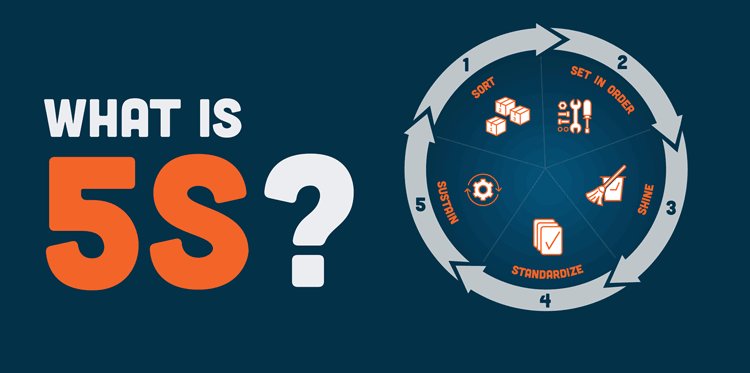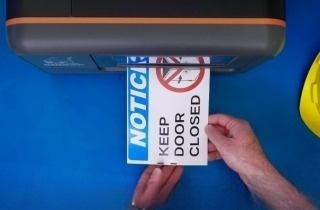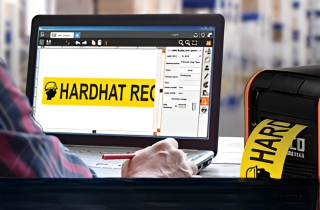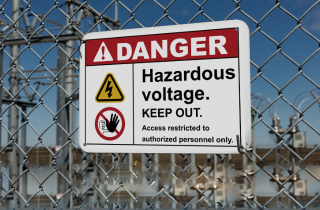
Look around you. Is your desk a little cluttered? Is there something nearby that is not necessary for your space? A half-eaten muffin, a few piles of paperwork, a wall of sticky notes, and maybe the TV remote somewhere. Now, think about your work as a whole. Do you have unnecessary items in your workspace? What about the warehouse or shop floor? Are some items in the wrong place, unorganized, or not even needed?
Having items that are in the wrong place, unorganized, or unnecessary contribute to downtime and waste, and lowers worker efficiency. However, a simple method can improve things dramatically: The 5S System Explained.
What is 5S in Manufacturing?
Manufacturers might have heard of the 5S method. What is 5S? Whys is it important for businesses? The 5S system is a lean manufacturing tool that improves workplace efficiency and eliminates waste. There are five steps in the system, each starting with the letter S. These steps feed into each other, so the sequence is important.
- Sort (seiri 整理)
- Set in order (seiton 整頓)
- Shine (seiso 清掃)
- Standardize (seiketsu 清潔)
- Sustain/self-discipline (shitsuke しつけ)
Clearing out unnecessary materials in step 1 (Sort) will provide the space needed to organize the important items in step 2 (Set In Order). Then, once the workspace is de-cluttered and organized, dirt and grime can be removed in step 3 (Shine). These changes to workers’ job duties and work environment should be reflected in updated procedures through step 4 (Standardize). Finally, those new procedures won’t amount to much unless the responsibility is assigned and progress is tracked—as required for step 5 (Sustain). And with responsibility and tracking, workers will continue to apply the steps, returning to step 1.
5S provides a systematic framework for organization and cleanliness. It helps facilities avoid lost productivity from delayed work or unplanned downtime, and DuraLabel customers like Ruby Rusine, of Social Success Marketing, attest to the organizational power of the 5S Method.
“Clutter definitely affects productivity. Less is more,” said Ruby Rusine of Social Success Marketing. “I can, *surprise*, think better when there is less stuff on my table or less tabs open. However, some people thrive with clutter around. I live with one here.”
What is Needed for 5S Longevity?
There are some helpful tools for 5S lean manufacturing that can make the process easier. These tools include process tools, 5S checklists, and visual communication tools like labeling and floor marking supplies.
“I find labels to be super helpful,” Rusine said.
5S can be used in any industry. Why do you think it would or wouldn’t work in your workplace? How can your facility get started with 5S? 5S can fail sometimes if there is no worker/top-level buy-in. There also needs to be a commitment to make 5S a long-term success. Be sure to track the details of the cost-savings from 5S. For some businesses, Sustain seems to be the hardest step. Manage 5S strategies to keep direction and focus.
“There is the word commitment to sustain this,” said Rusine. “This is a great habit to carve because the cue or the motive is right. I need to change my routine to improve on getting my table clutter-free from one day to two days.”
Need help? Download our free 5S System Best Practice Guide or a free 5S Color Code Chart to help you start or sustain your 5S program.
Related Resources

The 5S System Explained: From Origins to Implementation
What Is the 5S System? The 5S system is a lean manufacturing tool that improves workplace efficiency and ...
Read
Boosting Workplace Efficiency Amid Labor Shortages: The Power of 5S
One of the most pressing challenges companies face is the shortage of skilled labor. As organizations strive ...
Read
The Advantages of Lean Manufacturing Tools: 5S, Kaizen, and TPM
Lean Manufacturing Advantages Womack and Jones, in their book Lean Thinking, define lean manufacturing as "a ...
Read.png)





